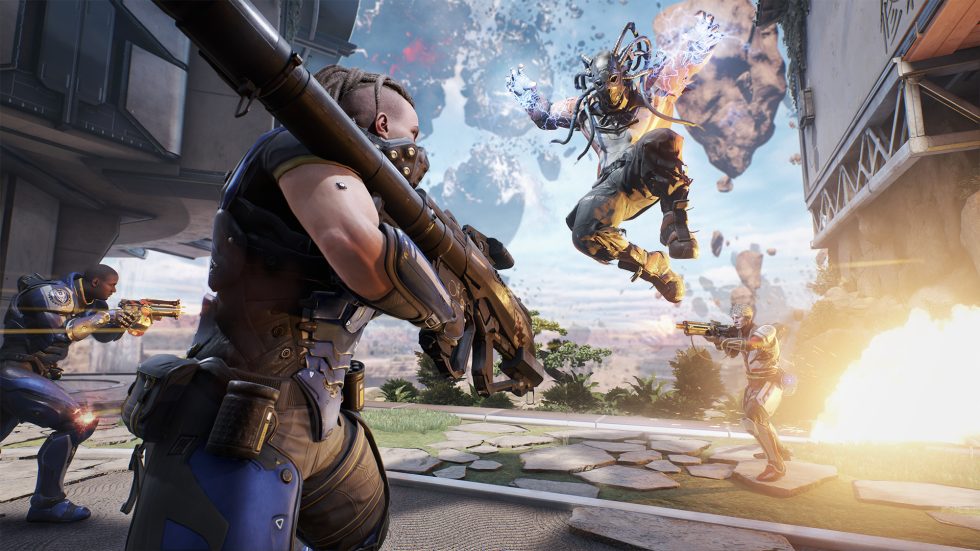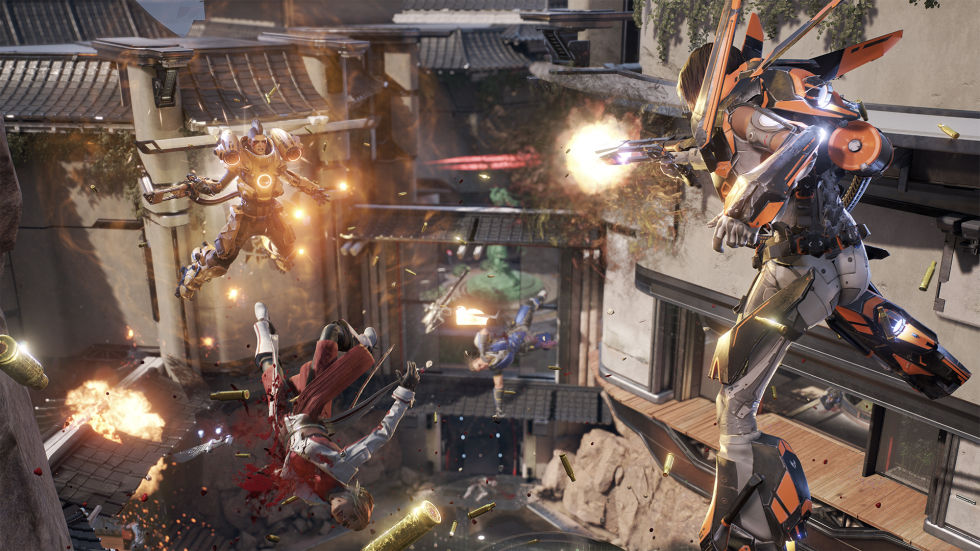
On paper, a description of LawBreakers—the next game from ex-Epic and Gears of War developer Cliff Bleszinski—sounds niche at best, stale at worst.
“An exhilarating role-based first-person shooter where the laws of physics can be shattered, creating unprecedented gravity-based combat in an ever-evolving bloody arena,” reads LawBreakers’ Steam page, sounding like something aimed at teenage boys with a penchant for the SyFy channel and a simple understanding of base adjectives.
Delve deeper, though, and it’s clear that LawBreakers is a game that the hyperbolic ad-speak fails to do justice to. As with the likes of basketball, baseball, and other successful sports, the entertainment factor doesn’t come from a dry description of the rules—and let’s face it, baseball sounds incredibly boring on paper—but from the presentation and minute details of the sport.
That LawBreakers is best described as a sport, rather than a videogame, is no accident. Bleszinski—one of the few legitimate videogame personalities of today—made a name for himself with big guns and bloody battles in the likes of Gears of War and Unreal Tournament. And yet it’s Boston-based sports teams, rather than shooters, that serve as his inspiration.
“Boston sports fans are very passionate, to the point of being insufferable,” Bleszinski grins. “Growing up it was one of those situations where I would be in the car with my dad and we’d always have the Red Sox or the Celtics on the radio, or we’d be home watching the Patriots play. Sports like those [baseball, basketball, American football] have been around for years, and their rules are so tight that they often end with a lot of drama.”
It’s the drama that caught, and still catches, Bleszinski’s attention—and it has very much found its way into LawBreakers. The presentation draws players in, but it’s a more sophisticated understanding of the rules that keeps them coming back for more.
“Watching people play LawBreakers for the first time is interesting because you can see that they pick up on the game type and the class system relatively quickly,” explains Bleszinski, “perhaps after just one or two sessions. It’s important to keep it deep, though, and that way people have something to learn. Either that or someone will make a YouTube video that helps them.”
One of LawBreakers’ modes—the only one I got to play—exemplifies this approach. “Battery” sees two teams battle for possession of a battery (read: ball) that they must return to their base (read: goal). Keep the ball in the goal long enough and you score a point. Score two points and your team wins.
It’s a very simple idea, but the drama comes from the finer rules. Once the battery is inside a base, players need to wait for a gauge to reach 100 percent, which takes a not-insignificant length of time. Thus, the opposition has plenty of chances to attack before the point is scored. This is made all the more dramatic by the fact that bases have many entrance points and that players are free to change class whenever they die. This means that each wave of attack carries a very real chance of looking nothing like the previous one.
Given that the classes range from characters that pack huge firepower and daunting health bars, to melee-focused blade-bearers who also carry a grappling hook, the safest tactic is often not to prepare too rigidly for any particular eventuality.
Then there’s the cooldown timer that appears once the battery gauge hits 100 percent, giving the opposition a final 20 seconds to try to snatch the points away. There’s also the second cooldown timer, known as the shield, to worry about. The shield is activated when a player is killed and drops the battery and prevents the opposing team from picking it back up immediately. Instead, the attacking team is forced to protect it for a few seconds until the shield disappears and they can scoop it up themselves. The idea is that every turnover must be earned.
“When you add a clock, you’ve instantly created suspense,” Bleszinski tells me, “so we’ve got a clock that counts up, and when it gets to the end the music starts swelling up and everyone starts, you know…”—getting excited, presumably.
“Before you get to around the 75 percent finished mark in Battery mode you see people going to the base and trying to hold it down, and it feels a bit like team deathmatch. When it gets down to the wire though, people start thinking about how much time they have left, what class they’re going to play, how they’re going to stack their team and that kind of thing. There’s the old saying from Yogi Bear: it ain’t over ’til it’s over.”
Sports, of course, are not the only influence here. You need only watch the trailers or cast an eye over the released imagery to pick up on the stylistic influence of the likes of Gears of War, Kill Bill, and Ghost in the Shell.
“I’m a huge pop-culture whore,” says Bleszinski. “If I’m not playing a game then I’m reading a graphic novel or watching a movie or TV show. It all goes into my head and then, through some weird process that I don’t even understand, it comes back out of the other side. The sword and gunplay that you generally tend to see in some of the interesting Tarantino movies… that has inspired me growing up.
I put it to Bleszinski that—given his love of pop culture and remixing of content—perhaps he is the closest thing the videogame industry has to its own Quentin Tarantino figure?
“I’d be flattered if someone said that, and if someone wants to say it then I’ll take it,” Bleszinski says, before explaining his theory that there are actually very few fresh ideas coming into the entertainment industry.
“There are still occasionally new ideas here and there that are still completely fresh and new, but often you get new movies that come out that are spiritual successors to Alien or some western, or whatever. There are only so many types of art, universes, and characters that exist before you start getting into things that people can’t understand and are too esoteric and weird.”
LawBreakers fits into this idea of controlled originality very snugly. As a first-person shooter, it is a natural successor to the games that have come before it. And yet it also borrows ideas from places that most game designers have little interest in or sophisticated knowledge of.
That combination came through when I played it: LawBreakers is simultaneously familiar and original, and I’ve no doubt that some players are going to love it.
But the competitive gaming space becomes more crowded every day, and the days of bankable hits are fast dwindling. Nothing stays new forever, and once the honeymoon period is over, LawBreakers will have to walk the tried-and-true path of regular updates, responding to player feedback and keeping on top of the competition.
Bleszinski is unquestionably an ideas man, but is he able to focus on a single idea long enough? As he says himself, sports have had years to refine their rules to become as popular as they are now. LawBreakers will need the same kind of dedication.
Lawbreakers is launching is launching exclusively on Steam later this year as a “premium” (read: not free-to-play) game. Registration for an upcoming alpha is currently live over on the LawBreakers site.
This post originated on Ars Technica UK











